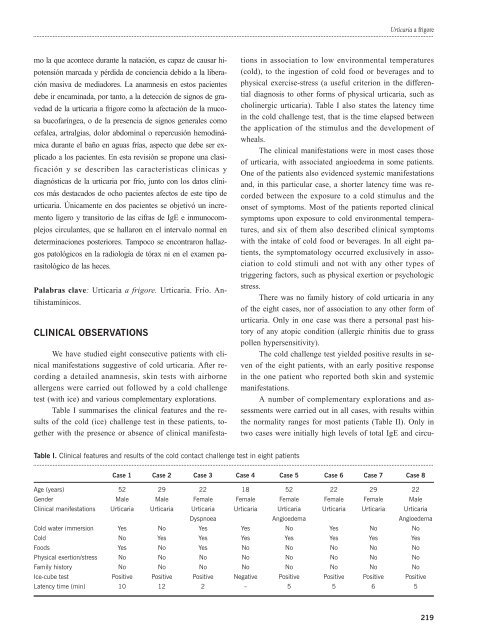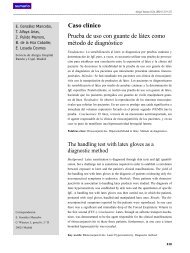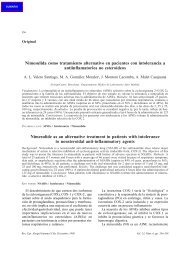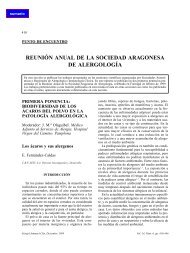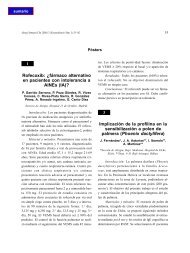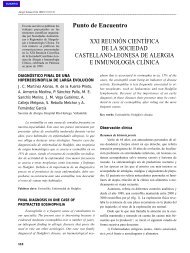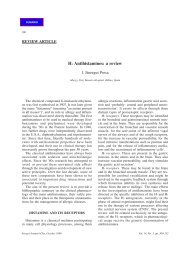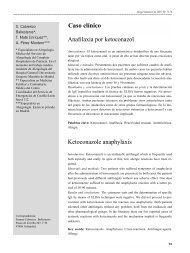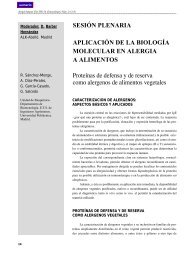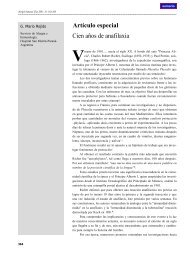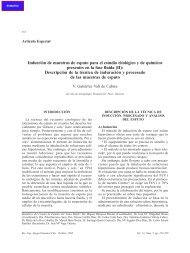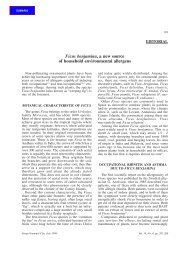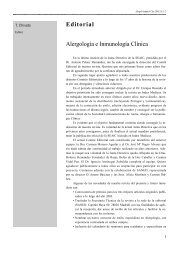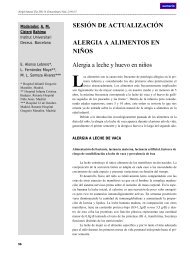a frigore - Alergología e Inmunología Clínica
a frigore - Alergología e Inmunología Clínica
a frigore - Alergología e Inmunología Clínica
You also want an ePaper? Increase the reach of your titles
YUMPU automatically turns print PDFs into web optimized ePapers that Google loves.
mo la que acontece durante la natación, es capaz de causar hipotensión<br />
marcada y pérdida de conciencia debido a la liberación<br />
masiva de mediadores. La anamnesis en estos pacientes<br />
debe ir encaminada, por tanto, a la detección de signos de gravedad<br />
de la urticaria a <strong>frigore</strong> como la afectación de la mucosa<br />
bucofaríngea, o de la presencia de signos generales como<br />
cefalea, artralgias, dolor abdominal o repercusión hemodinámica<br />
durante el baño en aguas frías, aspecto que debe ser explicado<br />
a los pacientes. En esta revisión se propone una clasificación<br />
y se describen las características clínicas y<br />
diagnósticas de la urticaria por frío, junto con los datos clínicos<br />
más destacados de ocho pacientes afectos de este tipo de<br />
urticaria. Únicamente en dos pacientes se objetivó un incremento<br />
ligero y transitorio de las cifras de IgE e inmunocomplejos<br />
circulantes, que se hallaron en el intervalo normal en<br />
determinaciones posteriores. Tampoco se encontraron hallazgos<br />
patológicos en la radiología de tórax ni en el examen parasitológico<br />
de las heces.<br />
Palabras clave: Urticaria a <strong>frigore</strong>. Urticaria. Frío. Antihistamínicos.<br />
CLINICAL OBSERVATIONS<br />
We have studied eight consecutive patients with clinical<br />
manifestations suggestive of cold urticaria. After recording<br />
a detailed anamnesis, skin tests with airborne<br />
allergens were carried out followed by a cold challenge<br />
test (with ice) and various complementary explorations.<br />
Table I summarises the clinical features and the results<br />
of the cold (ice) challenge test in these patients, together<br />
with the presence or absence of clinical manifesta-<br />
Table I. Clinical features and results of the cold contact challenge test in eight patients<br />
Urticaria a <strong>frigore</strong><br />
tions in association to low environmental temperatures<br />
(cold), to the ingestion of cold food or beverages and to<br />
physical exercise-stress (a useful criterion in the differential<br />
diagnosis to other forms of physical urticaria, such as<br />
cholinergic urticaria). Table I also states the latency time<br />
in the cold challenge test, that is the time elapsed between<br />
the application of the stimulus and the development of<br />
wheals.<br />
The clinical manifestations were in most cases those<br />
of urticaria, with associated angioedema in some patients.<br />
One of the patients also evidenced systemic manifestations<br />
and, in this particular case, a shorter latency time was recorded<br />
between the exposure to a cold stimulus and the<br />
onset of symptoms. Most of the patients reported clinical<br />
symptoms upon exposure to cold environmental temperatures,<br />
and six of them also described clinical symptoms<br />
with the intake of cold food or beverages. In all eight patients,<br />
the symptomatology occurred exclusively in association<br />
to cold stimuli and not with any other types of<br />
triggering factors, such as physical exertion or psychologic<br />
stress.<br />
There was no family history of cold urticaria in any<br />
of the eight cases, nor of association to any other form of<br />
urticaria. Only in one case was there a personal past history<br />
of any atopic condition (allergic rhinitis due to grass<br />
pollen hypersensitivity).<br />
The cold challenge test yielded positive results in seven<br />
of the eight patients, with an early positive response<br />
in the one patient who reported both skin and systemic<br />
manifestations.<br />
A number of complementary explorations and assessments<br />
were carried out in all cases, with results within<br />
the normality ranges for most patients (Table II). Only in<br />
two cases were initially high levels of total IgE and circu-<br />
Case 1 Case 2 Case 3 Case 4 Case 5 Case 6 Case 7 Case 8<br />
Age (years) 52 29 22 18 52 22 29 22<br />
Gender Male Male Female Female Female Female Female Male<br />
Clinical manifestations Urticaria Urticaria Urticaria Urticaria Urticaria Urticaria Urticaria Urticaria<br />
Dyspnoea Angioedema Angioedema<br />
Cold water immersion Yes No Yes Yes No Yes No No<br />
Cold No Yes Yes Yes Yes Yes Yes Yes<br />
Foods Yes No Yes No No No No No<br />
Physical exertion/stress No No No No No No No No<br />
Family history No No No No No No No No<br />
Ice-cube test Positive Positive Positive Negative Positive Positive Positive Positive<br />
Latency time (min) 10 12 2 – 5 5 6 5<br />
219


